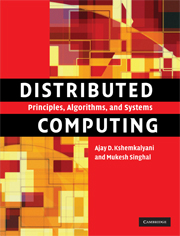Book contents
- Frontmatter
- Contents
- Preface
- 1 Introduction
- 2 A model of distributed computations
- 3 Logical time
- 4 Global state and snapshot recording algorithms
- 5 Terminology and basic algorithms
- 6 Message ordering and group communication
- 7 Termination detection
- 8 Reasoning with knowledge
- 9 Distributed mutual exclusion algorithms
- 10 Deadlock detection in distributed systems
- 11 Global predicate detection
- 12 Distributed shared memory
- 13 Checkpointing and rollback recovery
- 14 Consensus and agreement algorithms
- 15 Failure detectors
- 16 Authentication in distributed systems
- 17 Self-stabilization
- 18 Peer-to-peer computing and overlay graphs
- Index
9 - Distributed mutual exclusion algorithms
Published online by Cambridge University Press: 05 June 2012
- Frontmatter
- Contents
- Preface
- 1 Introduction
- 2 A model of distributed computations
- 3 Logical time
- 4 Global state and snapshot recording algorithms
- 5 Terminology and basic algorithms
- 6 Message ordering and group communication
- 7 Termination detection
- 8 Reasoning with knowledge
- 9 Distributed mutual exclusion algorithms
- 10 Deadlock detection in distributed systems
- 11 Global predicate detection
- 12 Distributed shared memory
- 13 Checkpointing and rollback recovery
- 14 Consensus and agreement algorithms
- 15 Failure detectors
- 16 Authentication in distributed systems
- 17 Self-stabilization
- 18 Peer-to-peer computing and overlay graphs
- Index
Summary
Introduction
Mutual exclusion is a fundamental problem in distributed computing systems. Mutual exclusion ensures that concurrent access of processes to a shared resource or data is serialized, that is, executed in a mutually exclusive manner. Mutual exclusion in a distributed system states that only one process is allowed to execute the critical section (CS) at any given time. In a distributed system, shared variables (semaphores) or a local kernel cannot be used to implement mutual exclusion. Message passing is the sole means for implementing distributed mutual exclusion. The decision as to which process is allowed access to the CS next is arrived at by message passing, in which each process learns about the state of all other processes in some consistent way. The design of distributed mutual exclusion algorithms is complex because these algorithms have to deal with unpredictable message delays and incomplete knowledge of the system state. There are three basic approaches for implementing distributed mutual exclusion:
Token-based approach.
Non-token-based approach.
Quorum-based approach.
In the token-based approach, a unique token (also known as the PRIVILEGE message) is shared among the sites. A site is allowed to enter its CS if it possesses the token and it continues to hold the token until the execution of the CS is over. Mutual exclusion is ensured because the token is unique.
Information
- Type
- Chapter
- Information
- Distributed ComputingPrinciples, Algorithms, and Systems, pp. 305 - 351Publisher: Cambridge University PressPrint publication year: 2008
Accessibility standard: Unknown
Why this information is here
This section outlines the accessibility features of this content - including support for screen readers, full keyboard navigation and high-contrast display options. This may not be relevant for you.Accessibility Information
- 2
- Cited by
